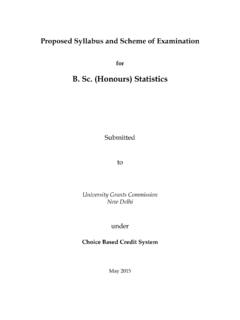Transcription of Introduction to Partial Differential Equations with ...
1 Introduction toPartial DifferentialEquations withApplicationsNNEli Zachrnanoglouand Dale W. ThoeIntroduction toPartial Differential Equationswith ZachmanoglouProfessor of MathematicsPurdue UniversityDale W. ThoeProfessor of MathematicsPurdue UniversityDover Publications, Inc., New YorkCopyright 1976, 1986 by E. C. Zachmanoglou and Dale W ThoeAll rights reserved under Pan American and International Copyright in Canada by General Publishing Company, Ltd ,30 Lesmill Road,Don Mills, Toronto, in the United Kingdom by Constable and Company, LtdThis Dover edition, first published in 1986, is an unabridged, correctedrepublication of the work first published by The Williams & Wilkins Company,Baltimore, 1976 Manufactured in the United States of AmericaDover Publications, Inc., 31 East 2nd Street, Mineola, N Y 11501 Library of Congress Cataloging-in-Publication DataZachmanoglou, E. to Partial Differential Equations with applicationsReprint.
2 Originally published. Baltimore: Williams & Wilkins, c1976 Bibliography. Differential Equations , Thoe, Dale WIIT itle.[ ]515 35386-13604 ISBN 0-486-65251-3 PREFACEI nwriting this introductory book on the old but still rapidly expandingfield of Mathematics known as Partial Differential Equations . our objec-tive has been to present an elementary treatment of the most importanttopics of the theory together with applications to problems from thephysical sciences and engineering. The book should be accessible tostudents with a modest mathematical background and should be usefulto those who will actually need to use Partial Differential Equations insolving physical problems. At the same time we hope that the book willprovide a good basis for those students who will pursue the study ofmore advanced topics including what is now known as the modern the book, the importance of the proper formulation ofproblems associated with Partial Differential Equations is of solution of any particular problem for a given Partial differ-ential equation are discussed only after a large collection of elementarysolutions of the equation has been the last five years, the book has been used in the form of lecturenotes for a semester course at Purdue University.
3 The students areadvanced undergraduate or beginning graduate students in mathematics,engineering or one of the physical sciences. A course in AdvancedCalculus or a strong course in Calculus with extensive treatment offunctions of several variables, and a very elementary Introduction toOrdinary Differential Equations constitute adequate preparation for theunderstanding of the book. In any case, the basic results of advancedcalculus are recalled whenever book begins with a short review of calculus and ordinary differ-ential Equations . A new elementary treatment of first order quasi-linearpartial Differential Equations is then presented. The geometrical back-ground necessary for the study of these Equations is carefully applications are discussed such as applications to problems ingas dynamics (the development of shocks), traffic flow, telephone net-works, and biology (birth and death processes and control of disease).
4 The method of probability generating functions in the study of stochasticprocesses is discussed and illustrated by many examples. In recent booksthe topic of first order Equations is either omitted or treated older books the treatment of this topic is probably inaccessible tomost brief discussion of series solutions in connection with one of thebasic results of the theory, known as the Cauchy-Kovalevsky theorem,is included. The characteristics, classification and canonical forms oflinear Partial Differential Equations are carefully students with little or no background in physics, Chapter VI," Equations of Mathematical Physics," should be helpful. In Chapters VII,VIII and IX where the Equations of Laplace, wave and heat are studied, thephysical problems associated with these Equations are always used tomotivate and illustrate the theory. The question of determining the well-posed problems associated with each equation is fundamental throughoutthe of separation of variables and Fourier series are intro-duced in the chapter on Laplace's equation and then used again in thechapters on the wave and heat Equations .
5 The method of finite differencescoupled with the use of computers is illustrated with an application tothe Dirichlet problem for Laplace's last chapter is devoted to a brief treatment of hyperbolic systemsof Equations with emphasis on applications to electrical transmissionlines and to gas problems at the end of each section fall in three main first group consists of problems which ask the student to providethe details of derivation of some of the items in the text. The problemsin the second group are either straightforward applications of the theoryor ask the student to solve specific problems associated with partialdifferential Equations . Finally, the problems in the third group introducenew important topics. For example, the treatment of nonhomogeneousequations is left primarily to these problems. The student is urged atleast to read these references cited in each chapter are listed at the end of thatchapter.
6 A guide to further study, a bibliography for further study andanswers to some of the problems appear at the end of the book contains roughly twenty-five percent more material than canbe covered in a one-semester course. This provides flexibility for planningeither a more theoretical or a more applied course. For a more theoreticalcourse, some of the sections on applications should be omitted. For amore applied version of the course, the instructor should only outline theresults in the following sections: Chapter III, Section 4; Chapter IV,Sections 1 and 2; Chapter V Sections 5, 6, 7, 8, and 9 (the classificationand characteristics of second order Equations should be carefully dis-cussed, however); Chapter VII, the proof of Theorem and are indebted to many of our colleagues and students for theircomments concerning the manuscript, and extend our thanks for theirhelp. Finally, to Judy Snider, we express our deep appreciation for herexpert typing of the UniversityE.
7 C. ZACHMANOGLOU1975 DALE W. THOETABLE OF CONTENTSPREFACECHAPTER I. SOMECONCEPTS FROM CAL-CULUS AND ORDINARY DIF-FERENTIAL and functions12. Surfaces and their normals. The implicit function theorem..53. Curves and their tangents114. The initial value problem for ordinary Differential equationsand systems16 References for Chapter I23 CHAPTERII. INTEGRAL CURVES AND SUR-FACES OF VECTOR curves of vector fields242. Methods of solution of dx/P =dy/Q=dz/R353. The general solution of+ +=0414. Construction of an integral surface of a vector field containinga given curve445. Applications to plasma physics and to solenoidal vectorfields51 References for Chapter II56 CHAPTERIII. THEORY AND APPLICATIONSOF QUASI-LINEAR AND LIN-EAR Equations OF order Partial Differential equations572. The general integral of+=R593. The initial value problem for quasi-linear first order and uniqueness of solution644.
8 The initial value problem for quasi-linear first order and nonuniqueness of solutions695. The initial value problem for conservation laws. The develop-ment of shocks726. Applications to problems in traffic flow and gas method of probability generating functions. Applicationsto a trunking problem in a telephone network and to thecontrol of a tropical disease86 References for Chapter III95vUviiiContentsCHAPTER IV. SERIES SOLUTIONS. THECAUCHY-KO VALE VSKY series. Analytic functions962. The Cauchy-Kovalevsky theorem100 References for Chapter IV111 CHAPTERV. LINEAR Partial Differential Equations . CHARAC-TERISTICS, CLASSIFICATIONAND CANONICAL 1121. Linear Partial Differential operators and their characteristiccurves and surfaces1122. The importance of characteristics. A very simple The initial value problem for linear first order Equations intwo independent Cauchy problem. The Cauchy-Kovalevsky the-orem and Holmgren's uniqueness theorem1326.
9 Canonical form of first order equations1337. Classification and canonical forms of second order equationsin two independent variables1378. Second order Equations in two or more independent varia-bles1439. The principle of superposition149 Reference for Chapter V152 CHAPTERVI. Equations OF MATHEMAT-ICAL PHYSICS1531. The divergence theorem and the Green's identities1532. The equation of heat conduction1563. Laplace's equation1614. The wave for Chapter VI170 CHAPTERVII. LAPLACE'S EQUATION1711. Harmonic functions1722. Some elementary harmonic functions. The method of separa-tion of of variables yielding new harmonic functions. Inver-sion with respect to circles and spheres1794. Boundary value problems associated with Laplace's equa-tion1865. A representation theorem. The mean value property and themaximum principle for harmonic functions1916. The well-posedness of the Dirichlet problem1977. Solution of the Dirichlet problem for the unit disc.
10 Fourierseries and Poisson's integral1998. Introduction to Fourier series2069. Solution of the Dirichlet problem using Green's The Green's function and the solution to the Dirichlet problemfor a ball in R322611. Further properties of harmonic functions23212. The Dirichlet problem in unbounded domains23513. Determination of the Green's function by the method ofelectrostatic images24014. Analytic functions of a complex variable and Laplace's equa-tion in two dimensions24515. The method of finite differences24916. The Neumann problem257 References for Chapter VII260 CHAPTERVIII. THE WAVE EQUATION2611. Some solutions of the wave equation. Plane and sphericalwaves2622. The initial value problem2713. The domain of dependence inequality. The energy Uniqueness in the initial value problem. Domain of depend-ence and range of influence. Conservation of energy2805. Solution of the initial value problem.














